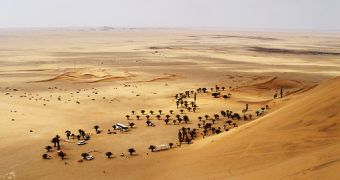Even though you would expect desert sands to move constantly under the wind, it appears that those in the Namib Sand Sea in Africa, have been there for the past million years, or at least this is the conclusion drawn by researcher Pieter Vermeesch, a geologist at the University of London, and his colleagues.
Hoping to track the movements of sand grains across the sand sea, the team measured levels of uranium and lead in the sands, and stated that they first came from the Orange River, south of the Namib desert.
Then came the analysis of radioactive isotopes made by cosmic rays, which allowed them to approximate the time the sand grains have spent in the area.
Vermeesch told OurAmazingPlanet that “all samples were collected on the crests of large — up to 200 meters (656 feet) high — dunes, quite a strenuous workout.”
What they found was that the sands have been there for at least a million years, constantly blown by the wind.
“While geologists have long known that the Namib Sand Sea is a very old landform, we had no idea that the individual sand grains spend so much time inside it,” Vermeesch said, adding that they were expecting a period of time ten times shorter.
Analyzing the desert sands is very important, say the scientists, because it is a way of knowing how climate evolved in time.
The Namib Sand Sea covers 34,000 square kilometers (13,125 square miles) and is one of the oldest and largest deserts in the world.
“While a lot of climate research has focused on the polar regions, deserts and particularly sand deserts remain relatively understudied and poorly understood, despite the fact that millions of people live in arid and semi-arid areas threatened by desertification,” reminded Vermeesch.
By better knowing sand seas, allows scientists to have an insight on ancient climates, because sand seas can only exist in hyper-arid environments.
Vermeesch explained that “the residence time of sand grains in a sand sea is a proxy for the sensitivity of desert areas to climate change.”
What the researchers still don't know is whether the sand dunes in the Namib Sand Sea have always been active, or whether their movements were cyclic, and where exactly do these sands come from.
But “to answer this question, additional samples will be required from the heart of the desert.”
The researcher's ultimate goal is to investigate the Sahara, but he says that this could be a bit difficult, “because of the political instability in the area.”
he adds that it's sad that not much is known about this desert, “because a better understanding of the Sahara would lead to a better understanding of human evolution, of the spread of humans out of Africa, of the negative feedback mechanisms that dust production in the Sahara has on global warming, and so forth.
“Important discoveries are waiting to be made in this part of the world,” he added.
The results of this research are in the journal Nature Geoscience.

 14 DAY TRIAL //
14 DAY TRIAL //